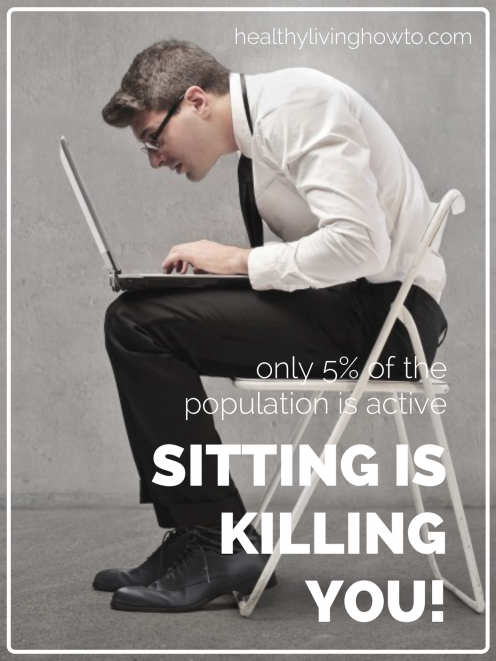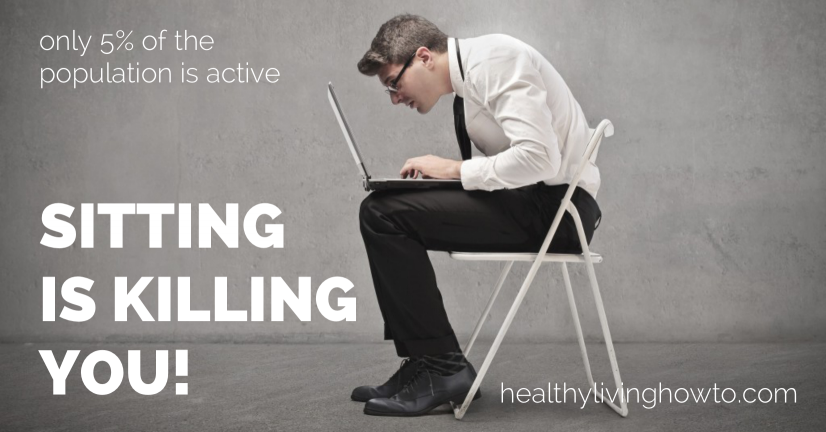Sitting is killing you. Being sedentary or sitting, is associated with many health risks, including a 112% increase in diabetes risk, 147% increase in cardiovascular disease risk, 90% increased risk in cardiovascular mortality and 49% increased risk of all-cause mortality. (Source) Just one day of sitting decreases insulin sensitivity, which elevates blood sugar and forces the body to produce more insulin to effectively metabolize incoming carbohydrates. Without activity, the body isn't able to clear triglycerides from the blood which leads to cardiovascular risk. Being sedentary, alters 4,500 genes and 34 metabolic pathways that determine how well the body’s cells function. (Source) Research is quite clear, it is no longer debatable, sedentary behaviors are an actual cause of disease.
Sixty-five percent of Americans say they are “active,” but according to studies done by actually measuring activity, only 5% of the population is active.
Before you pat yourself on the back for your “gym rat” status, those who exercise are not immune to these risks. While exercise is a healthy habit with many benefits, this is not about the one hour a day spent at the gym, but the other 15 hours, assuming 8 hours of sleep. One researcher coined the term “exercising couch potato” to describe those of us who are faithful exercisers but outside of our daily workouts, spend a lot of time sitting. Exercise has an important role in a healthy lifestyle, but it does not offset the effects of being sedentary.
The bottom line is this, long periods of time spent being sedentary is just not healthy for any body.
At one time the television was blamed for our lack of movement, however, the truth is, it is not the TV, but our sedentary jobs and lifestyle habits. When scientists compared the lifestyles led by those in the 1800s, a time period when diabetes and obesity were unheard of, versus the modern desk jockey, they found, on average we walk about 5 miles less per day which is roughly 10,000 steps, give or take a few.
Which leads right into what most experts agree to be an ideal goal for a healthy lifestyle — walk 10,000 steps per day. It doesn’t stop there, though, in fact Dr. John Berardi, founder of Precision Nutrition believes “when people increase their level of basic movement, in conjunction with doing a few hours per week of purposeful high intensity exercise, the magic starts to happen.”
This magic he is referring to is lower body weight, less body fat and improved health, of course taking healthy nutrition into account.
A Few Tips for Increasing Activity
1. Wear an Activity Monitor
We can’t change that which we don’t measure, which is where an activity monitor comes in. I wear and recommend a Fitbit. This little gadget gives instant feedback on daily activity level. It is wireless and syncs effortlessly with a computer or smartphone. I suggest you wear an activity monitor for a few days to get a gauge on what your daily steps are, then challenge yourself to increase it until you hit the recommended 10,000 steps a day.
2. Look for Opportunities to Be Active
The vast majority of the population works in an office setting, behind a computer screen. If this is you, then at first you may have to look for opportunities to be more active throughout your work day. Stand up and pace around your office when on a phone call. If you don’t need to be taking notes while meeting with a co-worker, conduct your meeting while you walk around your office building. Park in the furthest parking spot, take the stairs and use the restroom on another floor all adds activity to your day.
 3. Ask About Changes at Work
3. Ask About Changes at Work
Many companies have health and wellness programs. Get on the committee and instigate change in your workplace. A 10-minute break a few times throughout the day to walk around the office, leads to a more productive employee. Standing desks and treadmill desks, may seem innovative today, but will be more commonplace as the we continue learn the health detriments of sitting. If you work from home and have a treadmill, I recommend a Surfshelf, which turns your treadmill into a desk for under $40, it's what I use. Looking to invest in a treadmill desk, this is a great model.
4. Be More Active in the Morning and Evening
Before sipping on your morning cup of coffee, put on your sneakers and catch a 20-minute walk. Don't just let the dog out for a potty break, get out the leash and take Fido along. Instead of watching TV after dinner, time to lace up your shoes again and take another 20 minute walk, this time bring the kids. If you got in two 10-minute walk breaks while at the office you just got 60 minutes of additional activity in your day. An evening walk is an excellent way to reduce stress and you may find you even fall asleep easier.
5. Set Movement Reminders
It's easy for most of us to get so focused on the task at hand that hours go by in a sitting position. To overcome this, set movement reminders using the timer on your cell phone or even a pop-up reminder on your calendar until getting movement becomes a habit.
How Active Are You?
There is a vast difference between peoples’ perceptions of how active they are and the reality of their levels of activity. Sixty-five percent of Americans say they are “active,” but according to studies done by actually measuring activity, only 5% of the population is active. It's time to get moving, my friends, moving more may save your life.
P.S. I walked and worked using my Surfshelf to write this blog post. According to my Fitbit, I clocked in 13,000 steps!
Click +1 Below Then Tell Me How You Get Movement During the Day
